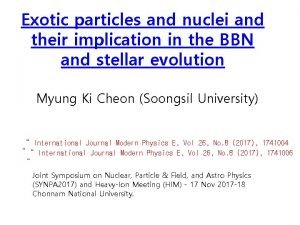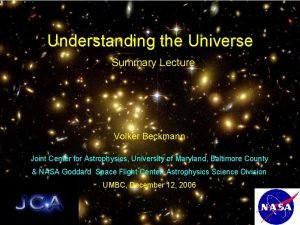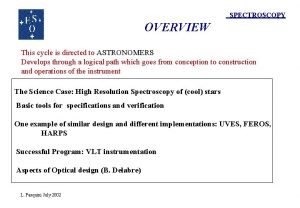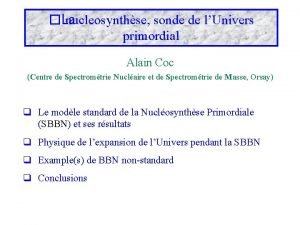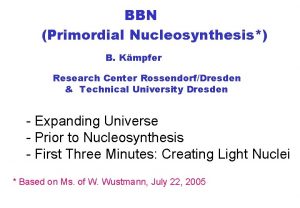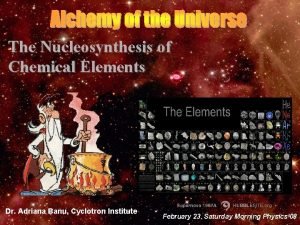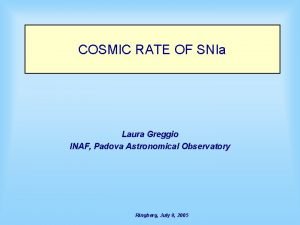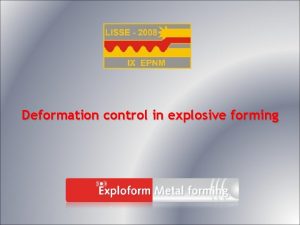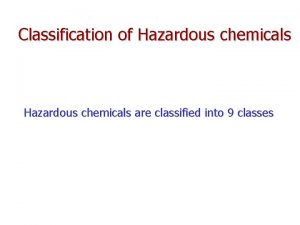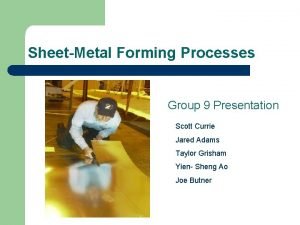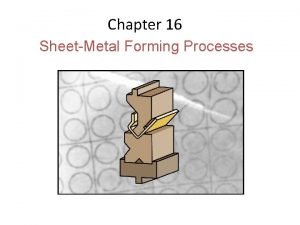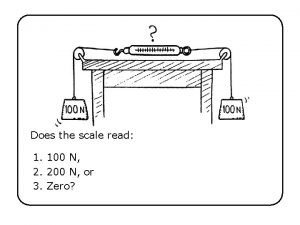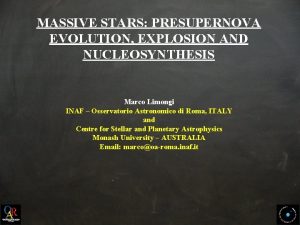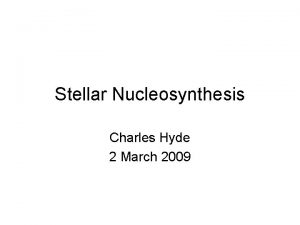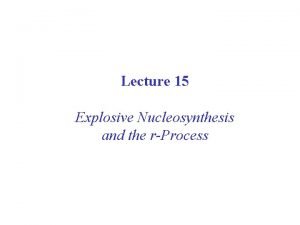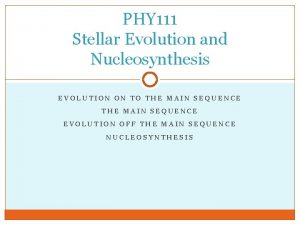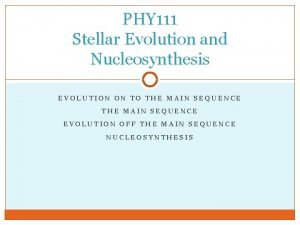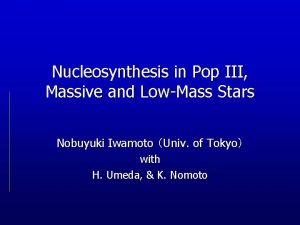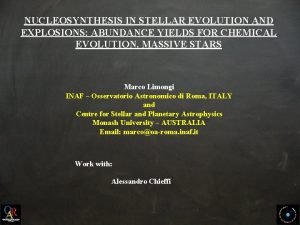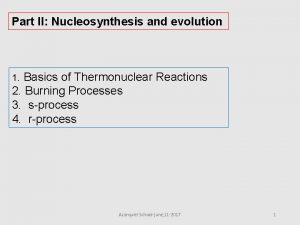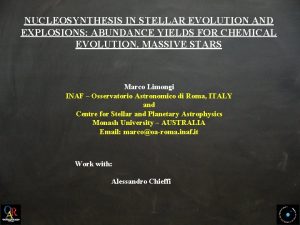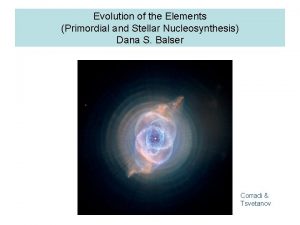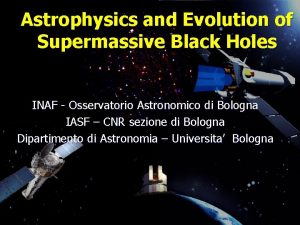INAF Presupernova evolution and explosive nucleosynthesis of massive

































- Slides: 33

INAF Presupernova evolution and explosive nucleosynthesis of massive stars Alessandro Chieffi Istituto Nazionale di Astro. Fisica (Istituto di Astrofisica Spaziale e Fisica Cosmica) & Centre for Stellar and Planetary Astrophysics – Monash University - Australia Email: alessandro. chieffi@iasf-roma. inaf. it In collaboration with Marco Limongi

What is a Massive star ? It is a star that goes through all the hydrostatic burnings from H to Si and explodes as a core collapse supernova Mup’ < Massive stars < MPISN >120 8 - 10 Why are Massive stars important in the global evolution of our Universe? Strong responsible for the chemical enrichment of the gas Eject an enormous amount of energy as neutrinos and kinetic energy of the ejecta Main producers of g ray emitters ( 26 Al , 60 Fe , 44 Ti , 56 Ni) Parents of a large fraction of neutron stars and black holes etc. . . . INAF

Intermediate mass stars and core collapse supernovae INAF Core collapse and thermonuclear supernovae SOLAR DISTRIBUTION Core collapse supernovae Intermediate mass stars and core collapse supernovae

Which is the present status of the modelling of these stars? H Maeder & Meynet - Chiosi & Bressan - Woosley, Weaver & Heger - Limongi & Chieffi He C The “FAR WEST” Ne Woosley, Weaver, Heger Almost nothing published yet Limongi, Chieffi O Nomoto, Umeda Si Heger , Woosley Limongi , Chieffi Expl. Burn. Mup’ Hirschi, Meynet. . . ( hydrostatic burning only and an a network ) 35 - 40 MO MPISN INAF

INAF New generation of massive stars extending between 11 and 120 MO: Chieffi and Limongi (2006 – hopefully) FRANEC (release 5. 050419) Main changes with respect to our previous models: Mass Loss included: Vink, J. S. , de Koter, A. , & Lamers, H. J. G. L. M. 2000, A&A, 362, 295 Vink, J. S. , de Koter, A. , & Lamers, H. J. G. L. M. 2001, A&A, 369, 574 de Jager, C. , Nieuwenhuijzen, H. , & van der Hucht, K. A. 1988, A&AS, 72, 259 Nugis, T. , & Lamers, H. J. G. L. M. 2000, A&A, 360, 227 OR Langer, N. 1989, A&A, 220, 135 Mixing treated as a diffusive process and fully coupled to the local burning

m 120 INAF g m CNO cycle g g H burning Convective core 11 m m g g m m 120 He burning g g 12 C / 16 O Convective core He core 11 3 a + 12 C(a, g)16 O m g m H burning shell

INAF At the end of the central He burning, each star ends up with: Nugis & Lamers 00 Langer 89 WNE-WCO MHe MCO Langer 89 Nugis & Lamers 00

INAF Moreover at the beginning of the central C burning. . . n n Central burning CO core n He core n

Burnings go on nicely through the C, Ne and O burnings. . . INAF

INAF He C Ne Mg O Si

Explosive burnings computed by adopting a kinetic bomb: INAF An outward velocity v 0 is imposed at M=1 MO and tuned to obtain the “desired” result: a) b) final kinetic energy of the ejecta the ejection of a given amount of 56 Ni A PPM hydrodynamic code has been developed to follow the passage of the shock wave through the mantle. ADIABATIC EXPANSION: RADIATION DOMINATED: NSE QSE 2 QSE Nugis & Lamers 00 Ne & C expl. Burn. WNEWCO MREMNANT => 1 foe MHe MH MH MCO => 1 foe MREMNANT => 0. 1 MO 56 Ni MHe MCO

Final kinetic energy = 1 foe 56 Ni ejected = 0. 1 MO (1051 INAF erg)

INAF NL 00 versus LA 89 mass loss rate in the WNE/WCO phases Final kinetic energy = 1 foe (1051 erg)

“HYDROSTATIC” ELEMENTS (4 He) He C (12 C) N (14 N) O(16 O) Ox$ F (19 F) Hc, s # Hec, s# Hc, s # Hec, s$ Cc, s $ Hec, s$ Nes # • Convection • 12 C(a, g)16 O Hes # “HYDROSTATIC”&“EXPLOSIVE” ELEMENTS Ne (20 Ne) Cs # Nex $ Na (23 Na) Cs # Nex$ Mg (24 Mg) Cs# Nex$ Al (27 Al) Cs # Nex$ P (31 P) Nex# 35 Cl Cl(Nex#) 37 Cl(Cs# Nex$) • • • Cshell properties 12 C(a, g)16 O Shock wave energy PURE “EXPLOSIVE” ELEMENTS Si (28 Si) Ox# S (32 S) Ox# Ar (36 Ar) Ox# Ca (40 V) Ca) V (51 O # x # 39 K Cr( (52 K) Fe) Sixi # Si. Si xi # xi O Sixxi# # Mn (55 Fe 55 Co) Sixi 45 45 Sc #( Sc, Ca) Six# (Cs# Nex$) Ti (48 Cr) Six # (Sixi #) 56 56 54 Fe ( Ni Fe Fe) Sixi # Six # Co (59 Ni) Six # 58 Ni ( Ni) Si # • M-R relation • electron density Ye • Shock wave energy • Mass cut • Time delay • (freeze out) INAF

Mass Loss in the WNE / WCO phases: Langer 89 - Nugis & Lamers 00 INAF

Mass Loss in the WNE / WCO phases: Langer 89 - Nugis & Lamers 00 INAF

INAF

INAF

The g ray emitters 26 Al and 60 Fe INAF

INAF Few global numbers: LA 89 NL 00 Remnant (Mass fraction) 8. 7% 15% Neutron stars (Number fraction) 84% 70% Black Holes (Number fraction) 16% 30%

CONCLUSIONS INAF Mass loss plays a major role in the determination of the final M-R relation IF it affects the size of the He core mass: Nugis & Lamers 00 He He Langer 89 MHe MCO MHe In both cases (NL 00 & LA 89), however, the amount of mass ejected (and nuclearly processed) is quite small. MCO MREMNANT Stars with M>35 MO do not produce any particular fingerprints on the production factors.

INAF

INAF Final kinetic energy = 1 foe (1051 erg)

INAF

INAF

INAF Thank You !

11 MO Begin of the core collapse 11 month before theexplosion Year before 1 day before the explosion INAF

120 MO 11 day 1 month before the explosion yearbefore theexplosion Begin of thethe core collapse INAF

INAF Sc Ti Fe Co Ni NSE V Cr Mn Ti Fe Si S Ar Ca K Ne Na Mg Al P Cl QSE 2 QSE f(r, T, Ye) f(r, T, Xi)

INAF Sc Ti Fe Co Ni NSE V Cr Mn Ti Fe Si S Ar Ca K Ne Na Mg Al P Cl QSE 2 QSE f(r, T, Ye) f(r, T, Xi)

INAF

Explosive burnings computed by adopting a kinetic bomb: An outward velocity v 0 is imposed at M=1 MO and tuned to obtain the “desired” result: a) b) final kinetic energy of the ejecta the ejection of a given amount of 56 Ni A PPM hydrodynamic code has been developed to follow the passage of the shock wave through the mantle. T 2 RADIATION DOMINATED: T 1 Fe core r 1 r 2 ignition ADIABATIC EXPANSION: INAF

INAF
 Inaf sede centrale
Inaf sede centrale Nuclear pasta
Nuclear pasta Primordial nucleosynthesis
Primordial nucleosynthesis Primordial nucleosynthesis
Primordial nucleosynthesis Primordial nucleosynthesis
Primordial nucleosynthesis Primordial nucleosynthesis
Primordial nucleosynthesis Becquerel
Becquerel Laura greggio
Laura greggio Trampolining scoring system
Trampolining scoring system Chapter 15 furniture styles and construction answer key
Chapter 15 furniture styles and construction answer key Massive comparative and superlative
Massive comparative and superlative Physical fitness is defined as
Physical fitness is defined as Intermittent rage disorder
Intermittent rage disorder Intermittent explosive disorder
Intermittent explosive disorder Upper explosive limit
Upper explosive limit Intermittent impulsive disorder
Intermittent impulsive disorder Explosive
Explosive Upper explosive limit
Upper explosive limit The ability to do strength work at an explosive pace
The ability to do strength work at an explosive pace Bulk deformation processes
Bulk deformation processes Explosive forming
Explosive forming Advantages of explosive forming
Advantages of explosive forming Ability to do strength work at an explosive pace
Ability to do strength work at an explosive pace Fortntw
Fortntw Ghs explosive
Ghs explosive Explosive
Explosive Sheet hydroforming
Sheet hydroforming Explosive disorder
Explosive disorder There once was a lady from china
There once was a lady from china Massive igneous rock from which tors develop
Massive igneous rock from which tors develop Seabed massive sulphides (sms)
Seabed massive sulphides (sms) Massive transformation purpose
Massive transformation purpose Massive transfusion protocol
Massive transfusion protocol Nellie hangs motionless by one hand from a clothesline
Nellie hangs motionless by one hand from a clothesline

